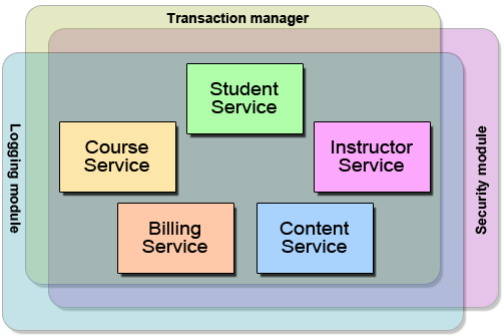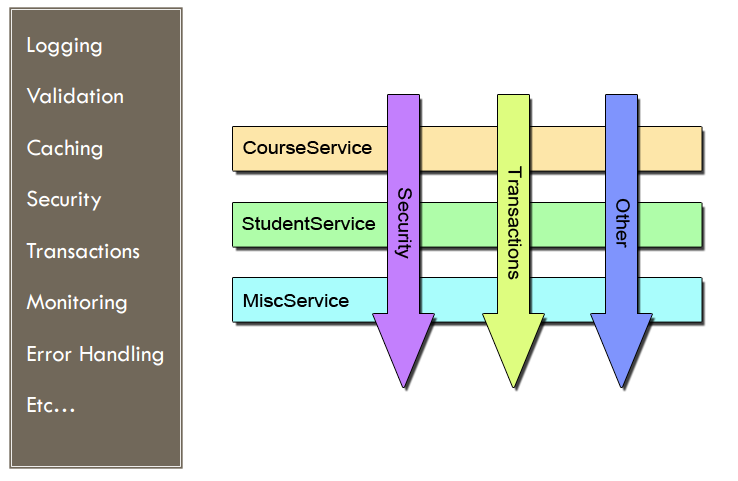Aspect Oriented Programming
What is it?
- is a programming paradigm
- extends OOP
- enables modularization of crosscutting concerns
- is second heart of Spring Framework
Sample usages
Cross cutting layer functionality like:
- security
- transactional
- logging
- monitoring
- cache

Example
A simple service method:
public Order getOrder(BigDecimal orderId) {
return (Order) factory.openSession().get(Order.class, orderId);
}
Add permissions check:
public Order getOrder(BigDecimal orderId) {
if (hasOrderPermission(orderId)) {
return (Order) factory.openSession()
.get(Order.class, orderId);
} else {
throw new SecurityException("Access Denied");
}
}
Add transaction management:
public Order getOrder(BigDecimal orderId) {
if (hasOrderPermission(orderId)) {
Order order;
Session session = factory.openSession();
Transaction tx = session.beginTransaction();
try {
order = (Order) session.get(Order.class, orderId);
tx.commit();
} catch (RuntimeException e) {if (tx!=null) {tx.rollback();}
} finally {session.close();}
return order;
} else { throw new SecurityException("Access Denied");}
}
Add cache:
public Order getOrder(BigDecimal orderId) {
if (hasOrderPermission(orderId)) {
Order order = (Order)cache.get(orderId);
if (order==null) {
Session session = factory.openSession();
Transaction tx = session.beginTransaction();
try {
order = (Order) session.get(Order.class, orderId);
tx.commit();
cache.put(orderId, order);
} catch (RuntimeException e) {if (tx!=null) {tx.rollback();}
} finally {session.close();}
}
return order;
} else { throw new SecurityException("Access Denied");}
}
What does AOP solve?

AOP concepts
Key words
- join point - any identifiable places in the program
- pointcut - defined collection of join points
- advice - logic implementation executed before, after or instead of reaching pointcut
- aspect - combination of advices and pointcuts; decides what should be executed in which place
- introduction - adding to new fields, methods, interfaces implementations to the class
- target object - object enriched with new logic
- AOP proxy - proxy object which encapsulates target object and adds new logic by the given aspects
- weaving - process of adding aspect to target object
- compile time
- load time
- runtime
OOP vs AOP
- OOP (Object Orianted Programming) composes application into object relation
- AOP (Aspect Oriented Programming) composes application into aspects
- AOP completes OOP and allows
- static hierarchy object enrichment
- introduce new functionalities
- grouping similar concepts in decoupled classes
- Aspect programming and reflection concept fulfill separation of concerns

| OOP | AOP |
|---|---|
| 1. Class – code unit that encapsulates methods and attributes | 1. Aspect – code unit that encapsulates pointcuts, advice, and attributes |
| 2. Method signature – define the entry points for the execution of method bodies | 2. Pointcut – define the set of entry points (triggers) in which advice is executed |
| 3. Method bodies – implementation of the business logic concerns | 3. Advice – implementation of cross cutting concern |
| 4. Compiler – convert source code to object code | 4. Weaver – construct code (source or object) with advice |
Spring AOP
- implemented in pure java
- no need for a special compilation process
- supports only method execution join points
- only runtime weaving is available
- AOP proxy
- JDK dynamic proxy
- CGLIB proxy
- configuration
- @AspectJ annotation-style
- Spring XML configuration-style
Aspect
Aspect declare:
@Aspect
public class EmptyAspect {
}
XML Configuration:
<!--<context:annotation-config />-->
<aop:aspectj-autoproxy proxy-target-class="false | true"/>
<bean class="org.springframework.aop.aspectj.annotation.AnnotationAwareAspectJAutoProxyCreator"></bean>
<bean class="example.EmptyAspect"/>
- proxy-target-class=”false” - used JDK Proxy
- proxy-target-class=”true” - used CGLIB
Pointcut
Sample pointcut declaration and composition:
@Aspect
public class ItemStatusTracker {
@Pointcut("execution(* approve(..))")
public void ifApprove() {}
@Pointcut("execution(* reject(..))")
public void ifReject() {}
@Pointcut("ifApprove() || ifReject()")
public void ifStateChange() {}
}
Execution examples:
@Aspect
public class ItemStatusTracker {
@Pointcut("execution(public * * (..))")
public void anyPublicMethods() {}
@Pointcut("execution(* get*(..))")
public void anyMethodsThatStartsWithGet() {}
@Pointcut("execution(* bank.BankService.*(..))")
public void anyMethodDefinedByAppropriateInterface() {}
@Pointcut("execution(* com.epam.pmc.service.*.*(..))")
public void anyMethodDefinedByAppropriatePackage() {}
}
More examples you can find on: http://static.springsource.org/spring/docs/3.0.x/spring-frameworkreference/html/aop.html#aop-pointcuts-examples
Advice
- associated with a pointcut expression
- a simple reference to a named pointcut
- a pointcut expression declared in place
- runs
- before
- after returning
- after throwing
- after (finally)
- around
Examples:
@Aspect
public class BankAspect {
@Pointcut("execution(public * * (..))")
public void anyPublicMethod() {}
@Before("anyPublicMethod()")
public void logBefore(JoinPoint joinPoint) {
//to do something
}
@AfterReturning(
pointcut="execution(* get*(..))",
returning="retVal")
public void logAfter(JoinPoint joinPoint, Object retVal) {
//to do something
}
@AfterThrowing(
pointcut = "execution(* bank..*ServiceImpl.add*(..))",
throwing = "exception")
public void afterThrowing(Exception exception) {
//to do something
}
@Around("@annotation(bank.Cached)")
public Object aroundCache(ProceedingJoinPoint joinPoint){
//to do something before
Object retVal = joinPoint.proceed();
//to do something after
}
}
XML Configuration
<?xml version="1.0" encoding="UTF-8"?>
<beans xmlns="http://www.springframework.org/schema/beans"
xmlns:xsi="http://www.w3.org/2001/XMLSchema-instance"
xmlns:aop="http://www.springframework.org/schema/aop"
xsi:schemaLocation="…">
<aop:config>
<aop:aspect id="bankAspectId" ref="bankAspect">
<aop:pointcut id="anyPublicMethod"
expression="execution(public * * (..))"/>
<aop:before pointcut-ref="anyPublicMethod" method="logBefore"/>
</aop:aspect>
</aop:config>
<bean id="bankAspect" class="bank.BankAspect"/>
</beans>
How does it work
- Spring creates Proxy for each enriched object. Caller is working on Proxy so beware of using
instanceofand==operators. - Creating proxy objects is transparent for beans and callers.
- Proxy enrich target object with aspects and the delegates executions.
Proxy overview:

Proxy chaining:

AOP Proxy
Spring AOP supports two types of proxy that are being created at runtime:
- JDK dynamic proxy - can only proxy by interface (so your target class needs to implement an interface, which will also be implemented by the proxy class).
- CGLIB proxy - CGLIB (and javassist) can create a proxy by subclassing. In this scenario the proxy becomes a subclass of the target class. No need for interfaces.
So Java Dynamic proxies can proxy: public class Foo implements iFoo where CGLIB can proxy: public class Foo.
Spring AOP vs AspectJ
Spring AOP
- no need for a special compilation process
- support only method execution pointcuts
- advise the execution of operations on Spring beans
AspectJ
- need AspectJ compiler or setup LTW
- support all pointcuts
- advice all domain objects
Custom Annotation example
Configuration:
<?xml version="1.0" encoding="UTF-8"?>
<beans xmlns="http://www.springframework.org/schema/beans"
xmlns:xsi="http://www.w3.org/2001/XMLSchema-instance"
xmlns:context="http://www.springframework.org/schema/context"
xmlns:aop="http://www.springframework.org/schema/aop"
xmlns:mvc="http://www.springframework.org/schema/mvc"
xsi:schemaLocation="
http://www.springframework.org/schema/beans
http://www.springframework.org/schema/beans/spring-beans-3.2.xsd
http://www.springframework.org/schema/context
http://www.springframework.org/schema/context/spring-context-3.1.xsd
http://www.springframework.org/schema/aop
http://www.springframework.org/schema/aop/spring-aop-3.0.xsd
http://www.springframework.org/schema/mvc
http://www.springframework.org/schema/mvc/spring-mvc-3.0.xsd">
<!-- Scans for application @Components to deploy -->
<context:annotation-config/>
<context:component-scan base-package="io.github.kospiotr.*" />
<!-- enable AOP -->
<aop:aspectj-autoproxy/>
</beans>
Define Annotation:
@Retention(RetentionPolicy.RUNTIME)
public @interface LogDuration {
String value();
}
Aspect definition:
@Aspect
public class AopExample{
//for any method with @LogDuration, no matter what the return type, name, or arguments are, call this method
@Around("execution(@io.github.kospiotr.aop.LogDuration * *(..)) && @annotation(logDurationAnnotation)")
public Object logDuration(ProceedingJoinPoint joinPoint, LogDuration logDurationAnnotation) throws Throwable {
//capture the start time
long startTime = System.currentTimeMillis();
//execute the method and get the result
Object result = joinPoint.proceed();
//capture the end time
long endTime = System.currentTimeMillis();
//calculate the duration and print results
long duration = endTime - startTime;
System.out.println(logDurationAnnotation.value()+": "+duration+"ms"); //you should use a logger
//return the result to the caller
return result;
}
}
Use Annotation:
@Component
public class Example{
@LogDuration("Hello World API")
public String getHelloWorld(){
try {
Thread.sleep(3000);
} catch (InterruptedException e) {
throw new RuntimeException("Sleep Interrupted", e);
}
return "Hello World";
}
}
Output:
Hello World API: 3002ms
